[1]
Campbell T, Williams C, Ivanova O, et al. Could 3D printing change the world?, Technologies, Potential, and Implications of Additive Manufacturing. Washington, DC: Atlantic Council, (2011).
Google Scholar
[2]
Murphy S V ,Atala A . 3D bioprinting of tissues and organs[J]. Nature Biotechnology, 2014, 32(8):773-785.
DOI: 10.1038/nbt.2958
Google Scholar
[3]
RengierF ,Mehndiratta A , Tengg-Kobligk H V , et al. 3D printing based on imaging data: review of medical applications[J]. International Journal of Computer Assisted Radiology and Surgery, 2010, 5(4):335-341.
DOI: 10.1007/s11548-010-0476-x
Google Scholar
[4]
Wohlers T, Caffrey T. Annual worldwide progress report of additive manufacturing and 3D printing state of the industry. USA: Wohlers Associates, (2015).
Google Scholar
[5]
Ladd C , Ju‐Hee So, Muth J , et al. 3D Printing of Free Standing Liquid Metal Microstructures[J]. Advanced Materials, 2013, 25(36).
DOI: 10.1002/adma.201301400
Google Scholar
[6]
Gu D, Meiners W, Wissenbach K, et al. Laser additive manufacturing of metallic components: materials, processes and mechanisms. International Materials Reviews, 2012, 57(3): 133-164.
DOI: 10.1179/1743280411y.0000000014
Google Scholar
[7]
Van Elsen M, Al-Bender F, Kruth J-P. Application of dimensional analysis to selective laser melting. Rapid Prototyping Journal, 2008, 14(1): 15-22.
DOI: 10.1108/13552540810841526
Google Scholar
[8]
Fallah V, Amoorezaei M, Provatas N, et al. Phase-field simulation of solidification morphology in laser powder deposition of Ti–Nb alloys. Acta Materialia, 2012, 60(4): 1633-1646.
DOI: 10.1016/j.actamat.2011.12.009
Google Scholar
[9]
Kundin J, Ramazani A, Prahl U, et al. Microstructure Evolution of Binary and Multicomponent Manganese Steels During Selective Laser Melting: Phase-Field Modeling and Experimental Validation. Metallurgical and Materials Transactions A, 2019, 50(4): 2022-2040.
DOI: 10.1007/s11661-019-05143-x
Google Scholar
[10]
Acharya R, Sharon J A, Staroselsky A. Prediction of microstructure in laser powder bed fusion process. Acta Materialia, 2017, 124: 360-371.
DOI: 10.1016/j.actamat.2016.11.018
Google Scholar
[11]
Ilin A, Logvinov R, Kulikov A, et al. Computer aided optimisation of the thermal management during laser beam melting process. Physics Procedia, 2014, 56: 390-399.
DOI: 10.1016/j.phpro.2014.08.142
Google Scholar
[12]
Hussein A, Hao L, Yan C, et al. Finite element simulation of the temperature and stress fields in single layers built without-support in selective laser melting. Materials & Design (1980-2015), 2013, 52: 638-647.
DOI: 10.1016/j.matdes.2013.05.070
Google Scholar
[13]
Roberts I A, Wang C, Esterlein R, et al. A three-dimensional finite element analysis of the temperature field during laser melting of metal powders in additive layer manufacturing. International Journal of Machine Tools and Manufacture, 2009, 49(12): 916-923.
DOI: 10.1016/j.ijmachtools.2009.07.004
Google Scholar
[14]
Loh L-E, Chua C-K, Yeong W-Y, et al. Numerical investigation and an effective modelling on the Selective Laser Melting (SLM) process with aluminium alloy 6061. International Journal of Heat and Mass Transfer, 2015, 80: 288-300.
DOI: 10.1016/j.ijheatmasstransfer.2014.09.014
Google Scholar
[15]
Kobayashi R. Modeling and numerical simulations of dendritic crystal growth. Physica D: Nonlinear Phenomena, 1993, 63(3):410-423.
DOI: 10.1016/0167-2789(93)90120-p
Google Scholar
[16]
Keller T, Lindwall G, Ghosh S, et al. Application of finite element, phase-field, and CALPHAD-based methods to additive manufacturing of Ni-based superalloys. Acta Materialia, 2017, 139: 244-253.
DOI: 10.1016/j.actamat.2017.05.003
Google Scholar
[17]
Ghosh S, Stoudt M R, Levine L E, et al. Formation of Nb-rich droplets in laser deposited Ni-matrix microstructures. ScriptaMaterialia, 2018, 146: 36-40.
DOI: 10.1016/j.scriptamat.2017.10.034
Google Scholar
[18]
Okamoto H. Nb-Ni (Niobium–Nickel). Journal of Phase Equilibria and Diffusion, 2008, 29(2): 210-210.
DOI: 10.1007/s11669-008-9277-0
Google Scholar
[19]
Tolochko N K, Khlopkov Y V, Mozzharov S E, et al. Absorptance of powder materials suitable for laser sintering. Papid Prototyping Journal, 2000, 6(3): 155-161.
DOI: 10.1108/13552540010337029
Google Scholar
[20]
Yin J, Zhu H, Ke L, et al. A finite element model of thermal evolution in laser micro sintering. The International Journal of Advanced Manufacturing Technology, 2016, 83(9-12): 1847-1859.
DOI: 10.1007/s00170-015-7609-x
Google Scholar
[21]
Hallensleben P, Schaar H, Thome P, et al. On the evolution of cast microstructures during processing of single crystal Ni-base superalloys using a Bridgman seed technique. Materials & Design, 2017, 128: 98-111.
DOI: 10.1016/j.matdes.2017.05.001
Google Scholar
[22]
Xiao W, Li S, Wang C, et al. Multi-scale simulation of dendrite growth for direct energy deposition of nickel-based superalloys. Materials & Design, 2019, 164: 107553.
DOI: 10.1016/j.matdes.2018.107553
Google Scholar
[23]
Ghosh S, Ma L, Ofori-Opoku N, et al. On the primary spacing and microsegregation of cellular dendrites in laser deposited Ni–Nb alloys. Modelling and Simulation in Materials Science and Engineering, 2017, 25(6): 065002.
DOI: 10.1088/1361-651x/aa7369
Google Scholar
[24]
Burden M, Hunt J. Cellular and dendritic growth. I. Journal of Crystal Growth, 1974, 22(2): 99-108.
Google Scholar
[25]
Kurz W, Fisher D. Dendrite growth at the limit of stability: tip radius and spacing. Acta Metallurgica, 1981, 29(1): 11-20.
DOI: 10.1016/0001-6160(81)90082-1
Google Scholar


